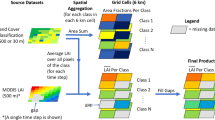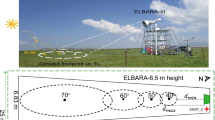Abstract
Charting snow cover by shortwave imaging requires visual analysis which is complicated by cloud coverage and poor surface illumination1,2. Microwaves, however, being almost unaffected by clouds and independent of solar illumination, are potentially useful for monitoring the extent and variation in snow cover, in climatological and hydrological studies. Data from spaceborne passive microwave sensors have previously been used to chart regional overland snow cover3–5; but charting hemispherical snow coverage was not feasible until high spatial resolution and multiple channels were combined in the Scanning Multichannel Microwave Radiometer (SMMR) launched in 1978 on the Nimbus-7 satellite. Here we compare SMMR data with shortwave images obtained over Asia to justify further use of microwave sensors in automated charting of seasonal snow cover under all weather conditions. Agreement between the two methods is found in ∼75% of the tested grid points.
This is a preview of subscription content, access via your institution
Access options
Subscribe to this journal
Receive 51 print issues and online access
$199.00 per year
only $3.90 per issue
Buy this article
- Purchase on Springer Link
- Instant access to full article PDF
Prices may be subject to local taxes which are calculated during checkout
Similar content being viewed by others
References
Smigielski, F. Glaciological Data 11, 63–69 (1981).
Matson, M. & Wiesnet, D. Nature 289, 451–456 (1981).
Kunzi, K. & Staelin, D. Proc. Tenth Int. Symp. Remote Sensing Envir., Ann Arbor, 1245–1253 (1975).
Fisher, A., Ledsham, B., Rosenkranz, P. & Staelin, D. Proc. Symp. Met. Obsns from Space: Their Contr. to First GARP Global Exp. 98–103 (Cospar 1976).
Foster, J. et al. Remote Sensing Envir. 10, 285–298 (1980).
Patil, S., Kunzi, K. & Rott, H. 11th Eur. Microwave Conf., Amsterdam, 227–232 (1981).
Kunzi, K., Patil, S. & Rott, H. IEEE Trans. Geosci. Remote Sensing 20, 452–467 (1982).
Hahn, D. & Shukla, J. J. atmos. Sci. 33, 2461–2462 (1976).
Gao, Y., Tang, M., Luo, S., Shen, Z. & Li, C. Bull. Am. met. Soc. 62, 31–35 (1981).
Dey, B. & Bhandu Kumar, O. S. R. U. J. appl. Met. 21, 1929–1932 (1982).
Fett, R. & Bohan, W. NAVENVPRECRSCHFAC Applic. Rep. 77–03, 1, (1977).
Kukla, G., Robinson, D. & Brown, J. Glaciological Data 11, 87–91 (1981).
Robinson, D. thesis, Columbia Univ. (1984).
Kukla, G. & Robinson, D. Glaciological Data 11, 103–119 (1981).
Maetzler, C., Schanda, E. & Good, W. IEEE Trans. Geosci. Remote Sensing 20, 57–66 (1982).
NORSEX Group, Science 220, 781–787 (1983).
Author information
Authors and Affiliations
Rights and permissions
About this article
Cite this article
Robinson, D., Kunzi, K., Kukla, G. et al. Comparative utility of microwave and shortwave satellite data for all-weather charting of snow cover. Nature 312, 434–435 (1984). https://doi.org/10.1038/312434a0
Received:
Accepted:
Issue Date:
DOI: https://doi.org/10.1038/312434a0
Comments
By submitting a comment you agree to abide by our Terms and Community Guidelines. If you find something abusive or that does not comply with our terms or guidelines please flag it as inappropriate.



